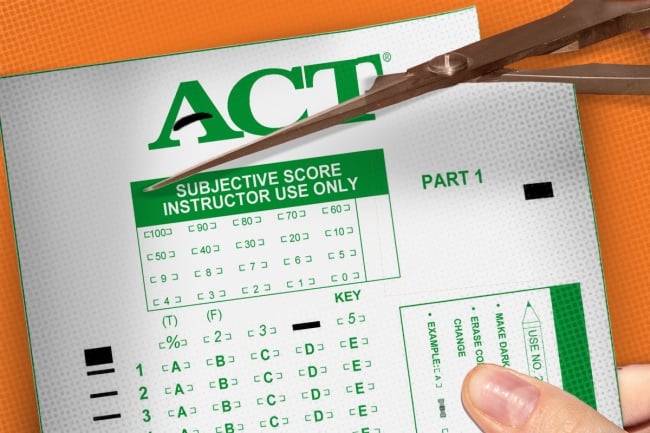You have /5 articles left.
Sign up for a free account or log in.

The ACT changes follow a similar evolution by the SAT this spring.
Photo illustration by Justin Morrison/Inside Higher Ed | Jira/rawpixel | joebelanger/iStock/Getty Images
The ACT announced two major changes to its eponymous exam last week, four months after the former nonprofit was acquired by the venture firm Nexus Capital.
Starting next spring, the ACT science section will be optional for students—just like the writing section, which has been optional since 2005. The test will also be a full hour shorter, with 44 fewer questions and truncated reading passages. An ACT spokesperson said the changes will make the test cheaper, though he did not say how much cheaper.
Unlike the SAT, which relaunched as a shorter, fully digital exam in March, the ACT will continue to be available both online and in pencil-and-paper form.
In an exclusive interview with Inside Higher Ed, ACT CEO Janet Godwin said the company’s main goal is to provide students with a more personally relevant exam and reduce stress and time demands on test takers.
“That is something we’ve heard loud and clear from students and in stakeholder research: more flexibility, more choices,” she said. “We want to support students where they are.”
Godwin said the ACT’s internal research showed that the score for the shortened exam without the science component is comparable to the composite score for the traditional exam; both are scored on a 36-point scale.
Showing Their Work
The new test won’t be available to everyone at once. Students taking the ACT online will have access to the “enhanced” test, as the spokesperson called it, next spring, and international students will get the new test in fall 2025. But for students taking it in person on specific dates sponsored by school districts, it won’t be available until spring 2026.
Godwin said ACT wanted to “phase in” adoption and implementation and give state partners and school districts time to adjust to the changes. But the gap means that, at least for one application cycle, colleges will receive ACT scores from two “fundamentally” different exams, as the company’s own press release put it, which admissions offices will have to evaluate as essentially the same test.
When asked about the potential challenges of comparing the two, Godwin again cited internal research.
“We’re confident in the research that we’ve done, the research that we continue to do, that those scores mean the same thing,” she said. “These changes are validated by research.”
When Inside Higher Ed asked to see the data, the ACT spokesperson wrote by email that the company’s research team is still in the process of “conducting a linking study so the scores of the enhanced test can be compared to the current test” and promised to forward the findings once they are “ready for publication.”
Akil Bello, director of the National Center for Fair and Open Testing and a standardized test critic, said the supposed psychometric comparability of the two tests was “hard to swallow.”
“Essentially, the statement from the testing industry appears to be, ‘As long as it has bubbles, it’s just fine,’” he said.
Michael Nettles, professor of psychometrics at Morgan State University and the former senior vice president for policy evaluation and research at the Educational Testing Service, said he believes it is possible ACT’s research shows a strong correlation between the two versions. But “it would be great to see the data,” he added.
“Even when it’s based upon evidence, there are questions about how representative the data are of the populations taking the test, which is why they need to be much more transparent,” he said. “Instead it’s like the old days, where we all have to place a lot of blind trust in the assessments.”
The Great Shortening
Though the changes follow closely on the heels of ACT’s purchase by Nexus Capital, Godwin said the testing company began planning for them more than a year before the acquisition.
“It had nothing to do with Nexus,” she said. “We don’t make these kinds of major changes overnight.”
Still, the ACT’s evolution reflects the market forces at work in the rapidly evolving testing industry, especially as its competitors make similar changes.
The College Board’s fully digital SAT is also significantly shorter than the old analog version—though, unlike the ACT, it is not cheaper. ETS cut the length of its marquee exam, the Graduate Record Examination, in half last May, a decision it made in the face of a steep financial downturn that has since resulted in hundreds of layoffs.
Godwin acknowledged that ACT “let the market drive the decision” in some areas—including the retention of a pencil-and-paper option; as soon as demand for that dries up, she said, the company will move to fully digital. In other areas, she said, student experience and higher-quality testing were the driving forces.
“Our analysis shows that students are running out of time, rushing to get through their last questions,” she said. “We want them to be able to demonstrate what they know and not just how fast they can do their work.”
To Nettles, it’s clear that recent moves to shorten exams and offer more flexibility are “market sensitive.”
“When colleges started going test optional and fewer students were taking them [during the COVID-19 pandemic], companies interpreted that as asking for less demanding, less time-intensive assessments,” he said.
He’s not criticizing test providers’ motivations, he said—as long as they remain transparent. But the imposition of market logic—especially in ACT’s case, as it transitions from a nonprofit to a piece of a for-profit company—is clearly an engine of transformation.
“This is an industry that has long been resistant to change, so even the smallest adjustment is an opportunity,” he said. “But it’s rare that these kinds of moves happen without bigger changes to the business model.”
Competitive Convergence
For years, ACT’s science section made it more popular than the SAT in states that mandated graduation exams because of its subject breadth. At the same time, many students have been intimidated by the science section.
Now, as some colleges begin to return to test requirements, Godwin hopes that making the science portion optional will expand the appeal of the ACT while retaining one of its unique advantages.
“While there are students, schools and states that see the science portion of the ACT as very important, there are many more students who aren’t pursuing STEM for whom it doesn’t make much sense,” Godwin said. “This is about giving those students a choice.”
Nettles said he hopes the ACT can continue to demonstrate its traditional advantages—namely its relevance to typical high school curricula, one of the reasons he said many high schools have required it over the SAT.
“One of the things that ACT has been successful at doing over the years is demonstrating the alignment between its content and high schools’ curriculum,” he said. “The question now becomes how this alignment can be illustrated the same way it has in the past.”
Godwin said ACT is not done evolving yet, hinting at further changes not only to its exam but also to its general business model and educational offerings, which she said will begin to expand to K-12 curriculum and workforce preparation.
“Keep your eyes on the ACT,” she said. “We’re picking up the pace.”









